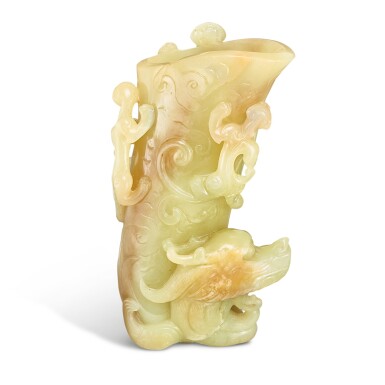
Property from the De An Tang Collection 德安堂藏玉
A yellow jade 'dragon' rhyton Qing dynasty, Qianlong period | 清乾隆 黃玉龍首盃
Auction Closed
April 29, 06:28 AM GMT
Estimate
1,500,000 - 3,000,000 HKD
Lot Details
Description
Property from the De An Tang Collection
A yellow jade 'dragon' rhyton
Qing dynasty, Qianlong period
德安堂藏玉
清乾隆 黃玉龍首盃
h. 12 cm
A Romance with Jade: From the De An Tang Collection, Yongshougong, Palace Museum, Beijing, 2004, cat. no. 123.
《玉緣:德安堂藏玉》,永壽宮,故宮博物院,北京,2004年,編號123
The present cup is impressive for the use of the highly esteemed yellow jade material and the elegantly carved form which references the past. Yellow jade was much favoured by the Qing court for its association with the imperial colour yellow. Since the Ming dynasty, it was recognised by scholars and connoisseurs as one of the most valued variations of nephrite. In his Yan xian qing shang jian / Refined Enjoyment of Elegant Leisure compiled in 1591, the dramatist-collector Gao Lian noted, ‘Of all jade materials, yellow stones with a mellow tone are the best and mutton-white ones come second’. Because of the rarity of the stone, brownish colourings were often worked into a piece, as seen on the present lot, to increase the overall size and show the carver’s great respect for the treasured material. Compare a related yellow jade rhyton, but larger in size, preserved in the Palace Museum, Beijing, illustrated in The Complete Collection of Treasures of the Palace Museum. Jadeware (III), Hong Kong, 1995, pl. 137.
Jade cups in the form of horns appeared in antiquity and continued to be appreciated until the Qing dynasty. See a Western Han prototype, excavated from the tomb of the Nanyue King Zhao Mo (r. 137-122 BC) located in Guangzhou, a celadon jade rhyton carved with a kui dragon below its mouth and spiral patterns in the background, the base with a bifurcated and striated tail, but lacking the dragon head of the present piece, included in the exhibition Jades from the Tomb of the King of Nanyue, Museum of the Western Han Tomb of Nanyue King, Guangzhou, and The Chinese University of Hong Kong Art Gallery, Hong Kong, 1991, cat. no. D44, pls 102-105. From around the Song dynasty, rhytons were carved with a mythical animal head at the base, perhaps as a later intervention to provide a visual explanation for the source of the bifurcated tail; see a Song dynasty example, formerly in the Cunliffe Collection, included in the Oriental Ceramic Society’s exhibition The Arts of the Sung Dynasty, London, 1960, cat. no. 252, and sold in these rooms, 9th October 2012, lot 3137. For related Qianlong examples, see a yellow jade rhyton carved with an inverted dragon head, formerly in the Gerald Godfrey Collection and the De An Tang Collection, sold in these rooms, 13th October 2021, lot 3605; and a pale celadon example sold at Christie’s London, 8th May 1972, lot 167. Compare also a related rhyton from the collection of Dr Ip Yee, illustrated in Chinese Jade Carving, Hong Kong, 1983, cat. no. 214.
此件取黃玉、採龍形以成角盃,用料考究,形制仿古。因「黃」與「皇」諧音,黃玉備受清宮青睞。明代以來,文人雅士多尊黃玉為玉中魁首。明人高濂,工於劇作,兼通收藏,1591年撰《燕閒清賞箋》,道「玉以甘黃為上,羊脂次之」。因材料稀貴,黃玉器多添褐色料以充盈尺寸,突顯匠心,此盃亦如是。參考一黃玉角盃,尺寸較大,一側鏤雕蟠螭為柄,下部凸雕龍首,藏北京故宮博物院,錄於《故宮博物院藏文物珍品全集:玉器(下)》,香港,1995年,圖版137。
玉角盃由來已久,自古至清,歷代不絕。比較一西漢例,南越趙眜(公元前137-122年在位)墓出土,地屬今廣州,青玉造,盃身雕刻夔龍,盃底作龍尾狀,分為兩股,與此盃有別,展於《南越王墓玉器》,西漢南越王博物館,廣州,及香港中文大學文物館,香港,1991年,編號D44,圖版102-105。約自宋代起,角盃底部乃作獸首形狀;比較一宋代例,肯理夫勛爵舊藏,展於東方陶瓷學會,《The Arts of the Sung Dynasty》,倫敦,1960年,編號252,售於香港蘇富比2012年10月9日,編號3137。見一乾隆黃玉例,盃底作倒置龍首,先後為高福履及德安堂收藏,再售於2021年10月13日,編號3605;及一青玉類例,如本品凸雕龍首向上,售於倫敦佳士得1972年5月8日,編號167。再比較一明末清初類例,為葉義醫生舊藏,載於《中國玉雕》,香港藝術館,香港,1983年,編號214。
You May Also Like










